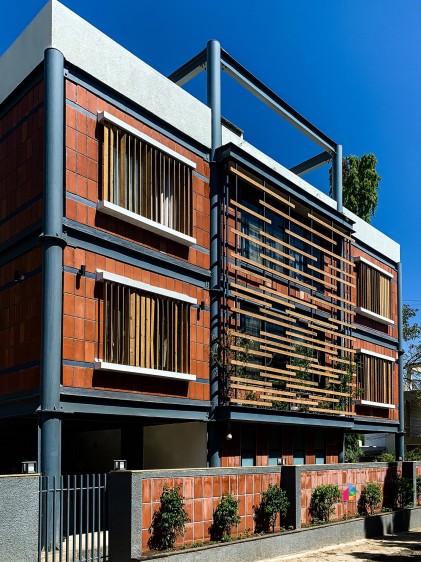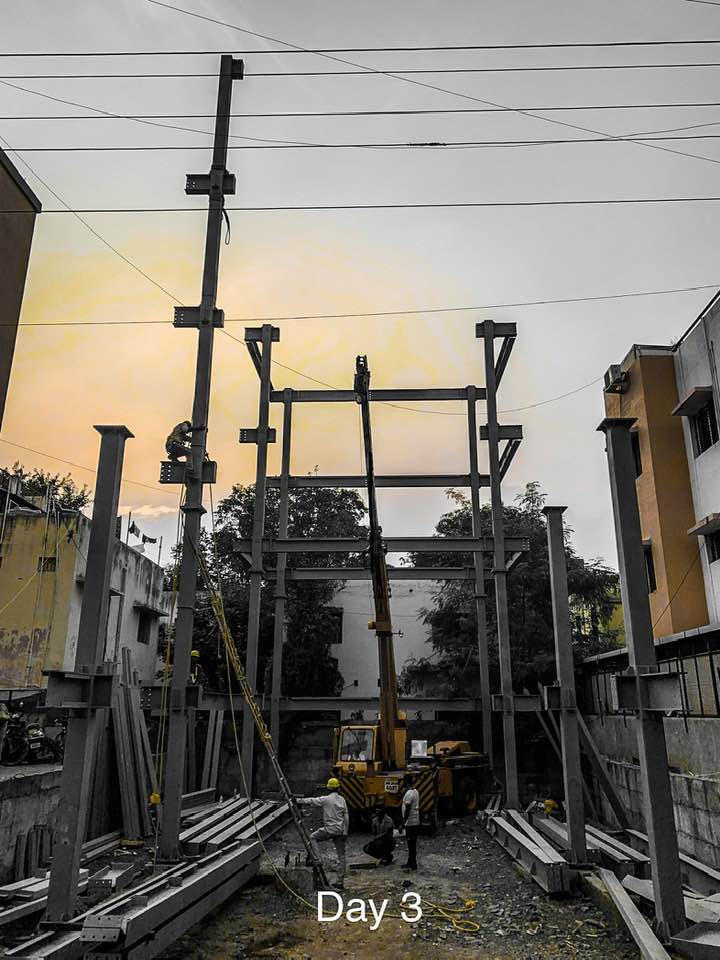This Architect Duo’s Steel Homes Are Durable, Sustainable and Earthquake-Resistant
“We realised early that we want to stick to sustainable architecture and taking into climatic aspects while planning buildings,” says Piyush.

Aurangabad-based architect duo Pooja and Piyush Kapadia spent just eight days to erect the basic steel structure of their client Ashok Amritkar’s house in Aurangabad’s Bhagyanagar. Eight days, imagine that! The next six months were spent in the electric wiring, plumbing, and interior designing work.
The reason for the speed was Steel and Concrete Composite Structures instead of the traditionally-used Reinforced Cement Concrete (RCC) method.
Known for their out-of-the-box thinking, the architect couple have always been keen on finding efficient and sustainable methods of construction.

“Steel is almost endlessly recyclable. Therefore nothing will go waste — it will always carry its own value. It is fire-resistant, earthquake resistant and has a lesser impact on the environment when compared to the regular construction material,” says Piyush.
Piyush and Pooja are both graduates from the Maharashtra Institute of Technology, Aurangabad. A few years after graduation, in 2003, the couple established Pooja & Piyush Associates in Aurangabad. “We realised early that we want to stick to sustainable architecture and taking into climatic aspects while planning buildings,” says Pooja.
“While there is a plethora of reasons why we chose to work with steel — some that stand out include, India being the third-largest producer and exporter of steel globally and that it is quick to assemble, thereby reducing construction time,” says Piyush.
Steel – A step toward eco-friendly architecture

“Our endeavour as architects has been to reduce the use of natural resources to the basic minimum,” says Piyush. Conventional structures use enormous amounts of cement, aggregates, sand, water, and a small amount of steel as well. Steel structures offer flexibility, large spans, precision in work and can be erected with minimum labour on
site.
“In conventional RCC buildings, 10 to 15 per cent more material is procured to accommodate bad workmanship or bad quality of materials and more resources and energy gets utilised,” says Piyush.
Another advantage for clients looking to build their home is the budget that they peg for these projects. “When the time taken for a project drags on, the cost of the material also keeps increasing. While when the project started if a bag of cement was costing Rs 250, by the time the project reaches completion, it costs almost Rs 350 and that adds a huge financial strain on the client,” he says.
Large commercial buildings world over have been using steel extensively for construction, where the structural steel sheets are pre-fabricated in factories and brought to the site for assembling. “With regard to the strength of the material [steel], there is no doubt about its durability,” says Piyush.
“But in RCC buildings, the ratio of water to cement changes with every new batch that is mixed, and therefore because the uniformity in mixing ratio is not fixed, one cannot be assured of the strength,” explains Piyush.
Sand and Water in Construction

Conventional methods of construction demand the use of sand and water in large quantities. “Because it is not easily available and often is mined illegally, there is a huge fluctuation in the demand and supply as well. Most projects are within the city limit which means that trucks can only come in at night, and that is also a disadvantage,” says Piyush.
Water is yet another resource that is needed in very large quantities for conventional buildings. “Without water, it is impossible to construct using the RCC method — the more the cement is cured the stronger the structure and therefore that much more water is utilised,” says Piyush.
This also leads to the drilling of several bore wells onsite, which in turn decreases the existing water table. In using steel as a structural framework, we reduce the use of water to more than 40 per cent.
Ashok Amritkar tells TBI, “I feel like my house is like a resort and I would recommend it to everyone. The biggest advantage for me has been that it was completed in just six months and that helped me stay within my budget.”
“With a built-up area of 2700 sq.ft., the house is very well ventilated and gets more natural light. Until almost 7.00 p.m. we do not even switch on any of the lights at home. This house is truly an owner’s pride.”
Fellow architect speaks

Rimpesh Sharma, an architect with over two decades of experience in the field shares, “While I cannot take away from all the benefits of using steel construction, it also has some points that hold developers back.”
“You need highly experienced labour to put together a steel structure. The margin of error for such structures is minimal, while the conventional concrete building structure has enough room for errors to be made and rectified,” he says. Even a millimetre of imprecision leaves gaps in the structure, which can lead to water seepages, stability, and other issues.
The speed of construction, of course, is a distinct advantage, which is why steel construction is preferred in developed nations for all large scale infrastructure projects.
A house that grows with you

Piyush and Pooja’s design can be altered any number of times without disturbing the structural strength of the building. “In the house built for Ashok and his family, there are no internal walls at all. The division of rooms has been done with the help of wooden furniture and partitions. Also, there are no columns in the house. This allows Ashok to change the internal structure as and when needed,” says Piyush.
“The tallest building in the world — the Burj Khalifa in the United Arab of Emirates — is made up of almost 70 per cent steel, and that is built on desert land. We have good solid soil here, so I knew I had nothing to worry about,” says Ashok.
They have also used hollow red bricks to line the walls and this keeps the temperature inside a few degrees cooler than the outside temperature. Since the lockdown, the family has been living in this house and hasn’t felt the need to use an air conditioner despite the outside temperature touching 40 degrees C.
Bank loans – an impediment?
One reason why architects and contractors perhaps stay away from working with steel is the availability of bank loans. In traditionally constructed homes, the bank can assess the building coming up and can release the loans accordingly — in smaller tranches as the construction progresses, thereby reducing risk for the banks.
In a steel building, the costs are front-ended and liquidity is required right at the beginning — to procure the materials and fabricate them. The site is vacant at this time, while most of the funds are already spent. This causes a bit of anxiety for the banks, as they are unable to assess the construction. Hence, the credibility of the builder and the borrower is required to convince the banks.
This can be especially relevant in the post COVID world where large construction groups can be a challenge to manage — circumstances which lend themselves to use steel more than concrete.

Steel has the potential to emerge as a credible alternative construction material if these aspects of skilled workmanship, loan availability, and customer mindsets can be addressed.
“It was my father who urged us to walk the talk and build our own home with steel, which we could then showcase to potential clients,” says Piyush.
It was this desire that drove them towards using steel as the primary source of construction material. And they eat what they cook — their own home was constructed using steel as the primary material, almost seven years ago.
(Edited by Saiqua Sultan)
If you found our stories insightful, informative, or even just enjoyable, we invite you to consider making a voluntary payment to support the work we do at The Better India. Your contribution helps us continue producing quality content that educates, inspires, and drives positive change.
Choose one of the payment options below for your contribution-
By paying for the stories you value, you directly contribute to sustaining our efforts focused on making a difference in the world. Together, let's ensure that impactful stories continue to be told and shared, enriching lives and communities alike.
Thank you for your support. Here are some frequently asked questions you might find helpful to know why you are contributing?


This story made me
-
97
-
121
-
89
-
167














